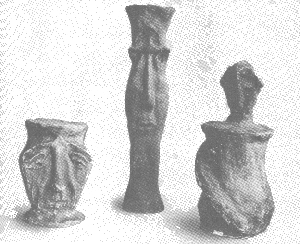Allgemein
 Sanctuary
of the Great Gods on Samothrace Sanctuary
of the Great Gods on Samothrace
The
sanctuary is located on the north coast of the island, to the
west of the ancient city. The earliest religious activity on
the site dates as early as the 7th century B.C. but the
permanent structures were built in the first half of the 4th
century B.C. and, mainly, in the 3rd century B.C., until the
early Imperial period. The sanctuary was used for the worship
and performance of the mysteries in honor of the Great Gods, a
religious event of great importance during Greek and Roman
antiquity. The identity and nature of the gods worshipped on
Samothrace, the so-called "Kabeiroi", still remains
problematic.
http://www.culture.gr/2/21/211/21119a/e211sa03.html
 Archaeological
Museum of Samothrace Archaeological
Museum of Samothrace
The
museum has four rooms and an atrium and houses:
- Room A:
the reconstructed architectural parts from the buildings
of the sanctuary
- Room B:
restored architectural parts, sculptures and coins found
in the sanctuary
- Room C:
sculpture, miniature objects, and pottery from the
sanctuary and the ancient city
- Room D:
finds from the cemeteries
- Atrium:
collection of inscriptions
http://www.culture.gr/2/21/211/21119m/e211sm02.html
Kabireion
(Sanctuary of the Kabeiroi)
The
sanctuary of the Kabeiroi is situated 8 km west of Thebes. It
was devoted to 2 deities, Kabeiros and Pais, both of unknown
origin, to which Demeter revealed mysteries aiming at
reinforcing the fertility of nature animals and human beings.
The Kabeiroi were worshiped as protectors of wineyards and
animal fertility; associated are 1400 representations of bulls
found at the site. The cult in the sanctuary began in the
archaic period (700-500 B.C.) and continued unil late
antiquity (4th c. A.D.). The pots on the sanctuary bear
typical decoration with grotesque carucaturated figures. Some
neolithic (6000-3000 B.C.) sherds from beneath the temple
attest an earlier occupation of the site, before its use as a
religious center.
http://www.culture.gr/2/21/211/21109a/e211ia13.html
AERIA
- Das Museum - Antikensammlung - Vitrine 17
 Attisch
rotfigurige Keramik, 5. Jh. v. Chr. Zwei Gefaesse mit der Darstellung
von Pygmaeen: Figurengefaess des Toepfers Sotades und ein "Kabirenbecher", Attisch
rotfigurige Keramik, 5. Jh. v. Chr. Zwei Gefaesse mit der Darstellung
von Pygmaeen: Figurengefaess des Toepfers Sotades und ein "Kabirenbecher",
verwendet im Mysterienkult der Kabiren in Theben.Der grosse
Kabirenbecher ist jetzt seit dem 6. November 1996 gereinigt
und frisch restauriert.
Auf der
attischen Pelike des Syleus-Malers ist ein Priester beim
Zerteilen des Fleisches eines Opfertieres dargestellt.
Normalerweise auch als Alltagsszene "beim Metzger",
veranschaulichen das lange Gewand des Mannes und vor allem die
einstmals weiss aufgemalten Kopfbinden, dass eine Kulthandlung
dargestellt ist.
http://www.phil.uni-erlangen.de/~p1altar/museum_html/vitrinen17-18/vitrine17.html
Princeton
Encyclopedia of Classical Sites kabirion
KABIRION
Boiotia,
Greece.
A sanctuary of the Kabeiroi
situated about 8 km W of Thebes
on the Thebes-Levadia road. Before the crossroads going to
Vagia, Leondari, and Thespies there is a bypath that leads to
the site.
The origin of
these deities is still unknown. Pausanias
says nothing about their nature or their mysteries (9.25.5),
merely stating that, according to the Thebans,
there was a city whose inhabitants were called Kabeiroi.
Demeter,
who came to the region, revealed some mystery to Prometheus,
one of the Kabeiroi,
and Aetnaios, his son. Pausanias
could not disclose Demeter's words. The mysteries were one of
Demeter's gifts to the Kabeiroi,
who had been chased out of their country by the Argives.
Demeter's wrath toward men was implacable, as was shown by the
punishment of the Persians
who came with Mardonios and dared to enter their temple and
pillage it, and later, after Alexander
seized Thebes,
when the Macedonians
who had entered the sanctuary of the Kabeiroi
were all killed by thunderbolts. The Kabeiroi
were said to be guardians of vines and the fertility of
animals (over 1400 representations of animals have been found,
also over 700 representations of the pais, either the son or
an accompanying slave).
According to Pausanias
(9.22),
just near the center of the city of Anthedon
NE of Thebes
there was a sanctuary of the Kabeiroi
related to a cult of Demeter
and Kore.
http://perseus.csad.ox.ac.uk/cgi-bin/text?lookup=pecs+kabirion&vers=english&browse=1
|




